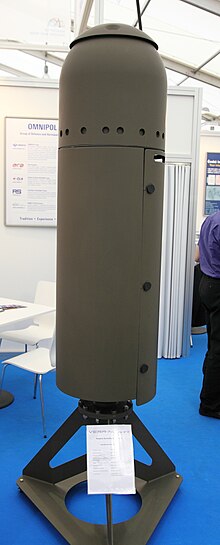Passive radar
Passive radar is a location technology that, in contrast to conventional radar, does not emit any electromagnetic energy to analyze its reflections . Instead, reflections and the Doppler effect of broadcasts from known radio , mobile radio or similar transmitters with constant radiation are evaluated. Passive radar devices can be counted among the bistatic radar devices whose transmitters are not cooperative.
The nearer transmitters, their exact frequencies , types of modulation and the geographical location are known to the computer-aided evaluation system. If a reflective object, for example a missile, moves in the radiation field of the transmitter, conclusions can be drawn about the flight path and the type and size of the object from the changes in frequency, amplitude , phase and transit time at the location of the passive radar . Because of the complicated and time-consuming calculations involved in signal evaluation, the method requires a very high computing power . The passive radar receivers can also be used for reconnaissance. Conversely, pure reconnaissance and warning receivers are not passive radar devices, since they can only be used for direction finding, but not a time of flight measurement and thus no direct distance measurement. For this reason, three locally separated receiving systems are sometimes interconnected for the evaluation, for example with the Goldhaube system in Austria.
Passive radar can only be located with difficulty because it does not emit any radiation of its own. This fact is considered a crucial military advantage. Another advantage discussed is the ability to track down stealth aircraft (stealth bomber B 2 and the F-117 Nighthawk of the United States Air Force ), which is only possible to a very limited extent with active radar technology in the usual frequency bands. The technology has been successfully implemented in practical tests since 2012.
Not only metallic objects, but also living beings influence the emission of electromagnetic waves. Tracking animals and people is therefore possible in principle. The Celldar technology is assumed to have a location accuracy that can even determine the location of individual people "at distances that can be used by the military" with the help of runtime measurements on a mobile phone that is carried along .
Current systems
Well-known systems are, for example, Celldar (cellphone radar) (use of cellular radio signals) or the Silent Sentry system (use of radio signals). The latter is able, for example, to monitor all air traffic over a metropolitan area. With the Tamara and Vera-E systems, for example, the range is around 450 kilometers. The radar monitoring system Kolchuga is not a passive radar because it can only aim for, and makes no runtime measurement. In 2018, the Twinvis system from Hensoldt was supposedly able to detect two F-35 fighter planes in German airspace. This claim is viewed critically by Lockheed, as the F-35s were fitted with radar reflectors on the way back from the ILA in Berlin and flew with the transponders switched on.
Historical systems
The radiation emitted by the British coastal protection radar Chain Home was tapped in the Second World War from 1942 by German radar devices using Klein-Heidelberg radar systems. A total of six locations were set up on the occupied Channel coast in France, Belgium and Holland. Since they did not emit any radiation of their own, their existence was only known to the British through intercepted radio communications. Surveys of captured radar soldiers after landing showed an average range of the system of 450 km. This is likely to have been the world's first operational bistatic radar system.
In the same year, glide bombs, which were guided by means of passive radar search, were tested for the first time in the USA. These Pelican- type bombs were not introduced, instead an active radar was used and used in the Bat type from 1944.
credentials
- ↑ Spiegel Online from September 14, 2012: Military technology: Passive radar robs stealth jets of invisibility
- ↑ Stealthy no more? A German radar vendor says it tracked the F-35 jet in 2018 - from a pony farm. In: c4isrnet.com. Retrieved October 10, 2019 .
- ↑ Bistatic radar, Introduction and Historical Background, Professor Hugh Griffiths, Royal Academy of RF sensor
- ^ Air Scientific Intelligence Interim Report, Heidelberg, IIE / 79/22, November 24, 1944, UK Public Record Office
- ^ Hugh Latimer Dryden : Guidance and Homing of Missiles and Pilotless Aircraft - A Report Prepared for the AAF Scientific Advisory Group , Headquarters Air Materiel Command, 1946.
Web links
- Klein Heidelberg description
- airpower.at: Passive radar function and overview of existing systems
- Deutschlandfunk broadcast “Research Current”, “Coastal Surveillance - Cellular Echo for Reconnaissance” from February 16, 2015

